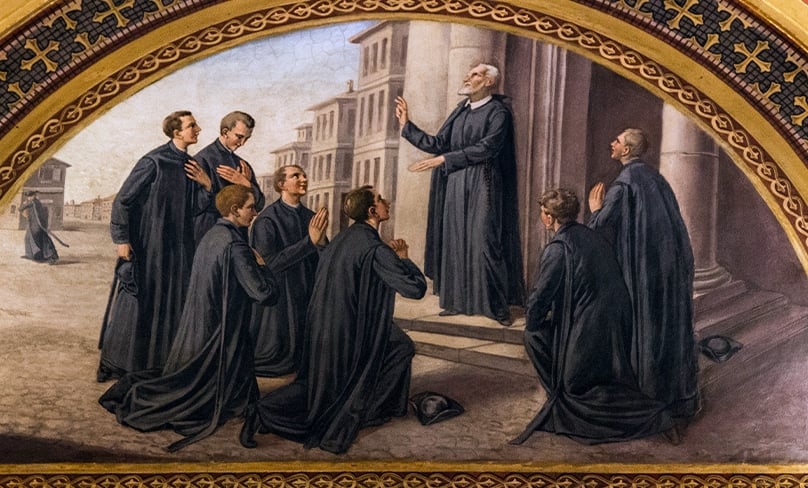
In a recent visit to Brisbane I met some of the priests of the Oratory founded by St Philip Neri. Can you tell me something about the saint and the origins of the Oratory?
St Philip was born in Florence, Italy, on 21 July 1515, one of the four children of Francesco and Lucrezia di Neri. His father was a lawyer and his mother came from a noble family.
Already from a very young age he was known for his cheerfulness and obedience, becoming known as “good little Phil”. He received his early education from the Dominican friars in Florence. When he was 18, Philip was sent to live with a wealthy relative in San Germano, near Naples, to work in and possibly inherit the family business.
However, soon after his arrival he had a mystical vision which radically changed his life. He lost all interest in engaging in business and felt a call to live a simple life in the service of the Church. Philip then went to Rome, where he tutored the sons of a family from Florence, helping them grow in virtue and faith.
“He encouraged his listeners to consider the Christian way of life and to practise good deeds, taking them to hospitals to care for the sick, or to church to pray and discover a relationship with Jesus Christ.”
During his first two years in Rome, Philip lived an ascetical life, dedicated to prayer and eating only small meals of bread, water and a few vegetables.
In 1535 Philip began studying theology and philosophy and, although he was considered a promising scholar, after three years of study he gave up all thought of priestly ordination.
He then went to help the poor people of Rome and to evangelise the city. He encouraged his listeners to consider the Christian way of life and to practise good deeds, taking them to hospitals to care for the sick, or to church to pray and discover a relationship with Jesus Christ. At night he would go to pray in the church or in the catacombs along the Appian Way.
On the eve of Pentecost in 1544, Philip saw what appeared to be a globe of fire, which entered his mouth and made him feel as if his heart were dilating. It filled him with such love for God that he screamed out, “Enough, enough, Lord, I can’t bear any more.”
In 1548, with the help of his confessor, he founded the Confraternity of the Most Holy Trinity, a group of laymen dedicated to the service of poor pilgrims in Rome and of the sick in their convalescence.

With his appealing nature Philip made friends at all levels of society, among them St Ignatius of Loyola, Pope St Pius V and St Charles Borromeo.
Even though at the age of 34 he had already achieved a great deal, his confessor, Fr Persiano Rossa, was determined that he would be more effective if he were ordained a priest.
Following this advice and after finishing his studies, he was ordained on 23 May 1551. After that he went to live with Fr Rossa and other priests at the hospital of San Girolamo, where he carried on his mission, spending long hours in the confessional and helping people of all ages to lead a better life.
They built a large hall, the oratory, at San Girolamo for the growing number of pilgrims, leading them in prayer, hymns, Scripture readings and talks. Soon this group of priests were called the Oratorians, because they would ring a bell to call the faithful to the oratory.
A few years later the Congregation of the Priests of the Oratory was founded, with priests dedicating themselves to helping others deepen their faith.
“Fr Philip became a trusted advisor to popes, kings and cardinals as well as to the poor. He soon earned the title of ‘Apostle of Rome.'”
They lived a simple rule, sharing a common table and performing spiritual exercises together. They did not take vows or renounce their property. The Congregation was officially approved by Pope Gregory XIII in 1575.
The Congregation was given the church of Santa Maria in Vallicella, but Fr Philip saw it necessary to demolish it and build a larger one. Donations came from all over, including from Charles Borromeo and Pope Gregory.
In 1577 the Chiesa Nuova, or New Church, was ready for the Oratorians to move there, although Fr Philip remained at San Girolamo for another seven years. Fr Philip became a trusted advisor to popes, kings and cardinals as well as to the poor. He soon earned the title of “Apostle of Rome”.
On the feast of Corpus Christi, 25 May 1595, Fr Philip was not well and he realised that his life was ending. He spent the day hearing confessions and receiving visitors and, before going to bed, he said, “Last of all, we must die”.
Around midnight he suffered a haemorrhage and he died, at the age of 80. His body lies in the Chiesa Nuova, where the Oratorians still serve, and he was canonised by Pope Gregory XV in 1622. His feast is celebrated on 26 May.
Related:
